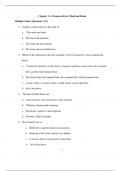Chapter 1: A Framework for Mind and Brain
Multiple Choice Questions (1-5)
1. Cognitive neuroscience is the study of
a. *The mind and brain
b. The brain and emotions
c. The mind and development
d. The brain and social behaviors
2. Which of the following is the best example of 'levels of analysis' when studying the
brain?
a. *A neuron in primary visual cortex, a region in primary visual cortex, the occipital
lobe, and the entire human brain
b. The frontal lobe, the temporal lobe, the occipital lobe, and the parietal lobe
c. A man's brain, a woman's brain, a child's brain, and an ape brain
d. All of the above
3. The three Global States are:
a. Consciousness, unconsciousness, and comatose
b. *Waking, sleeping and dreaming
c. Emotional, cognitive, and analytical
d. Newborn, child, and adult
4. The Cortical Core is:
a. Believed to support human consciousness
b. Made up of the cortex and the two thalami
c. A massive hub of connectivity in the brain
d. *All of the above
1
,5. According to the theater analogy for the Global Workspace Theory developed by Baars:
a. The entire theater represents unconscious processes
b. *The spotlight on the stage represents voluntary attention
c. The spotlight on the stage represents working memory
d. None of the above
Short Answer Questions (1-3)
1. Describe briefly the various elements of the theater (e.g., stage, audience, backstage) used
as an analogy for the Global Workspace Theory and what they are proposed to represent
in human cognition.
The theater analogy for the global workspace theory. According to this analogy, the
entire theater -- stage, audience, players, and backstage areas -- form the basis of
conscious and unconscious brain processes. The theater stage represents working
memory. A spotlight on the stage represents voluntary attention. Only the stage contents
illuminated by the attentional spotlight are conscious. The rest of the theater represents
the vast unconscious store of knowledge and memories that can enter the contents of
consciousness once they are on the stage and under the spotlight. A key point here is that
the spotlight of attention on the stage is very limited in capacity: it represents just a small
portion of the stage (working memory), which in turn represents a small portion of the
vast theater (unconscious knowledge and processes).
2. Explain how the three Global States are reflected in shifting levels of awareness and
wakefulness.
For healthy individuals, our typical conscious state includes a balance of full
wakefulness and awareness. As we move through the three global states of waking,
sleeping, and dreaming, our level of awareness (contents of our consciousness) is
coupled with our level of wakefulness. As we begin to feel sleepy, then, both the levels of
awareness and wakefulness drop until we reach deep sleep where we are neither aware
nor awake.
3. Briefly describe the cortical core and the role it plays in cognition.
A generally-held belief, supported by mounting evidence, is that the cortical core
supports human consciousness: the mighty thalamus located deep in the heart of the
brain connects to nearly every region in the cortex and together the two thalami and the
cortex form the cortical core, the central machinery of the brain.
2
, The two thalami are nestled into the center of the brain and form a massive
influence over the cortex and the brain in general. The thalamo-cortical core, made up
of the thalami and the cortex, can almost be thought of as a single massive hub that
provides the lightning fast connectivity needed for waking cognition and the modulatory
influences required for shifting the brain through the stages of sleep and the states of
consciousness. Together they form the target for anesthesia and, when damaged, the
basis for sustained unconsciousness and vegetative states.
3
, Chapter 2: The brain
Multiple Choice Questions (1-10)
1. The four lobes of the cortex are the:
a. *Temporal, parietal, occipital, and frontal
b. Frontal, medial, dorsal, and ventral
c. Sagittal, medial, coronal, and axial
d. Inferior, superior, anterior, and posterior
2. The brain is typically 'sliced' into three planes:
a. Ventral, dorsal, and medial
b. *Sagittal, coronal, and axial
c. Frontal, temporal, and parietal
d. Coronal, dorsal, and horizontal
3. Which of these brain terms are describing a similar place in the brain?
a. *Superior frontal lobe and dorsal frontal lobe
b. Inferior temporal lobe and dorsal temporal lobe
c. Anterior parietal lobe and ventral occipital lobe
d. Posterior occipital lobe and superior parietal lobe
4. One way to describe the sulci and gyri in the cortex is
a. Sulci are small bumps and gyri are small grooves
b. Sulci are gray matter and gyri are white matter
c. *Sulci are small grooves and gyri are small bumps
d. Sulci are white matter and gyri are gray matter
5. The massive fiber bridge between the left and right cerebral hemispheres is:
1




